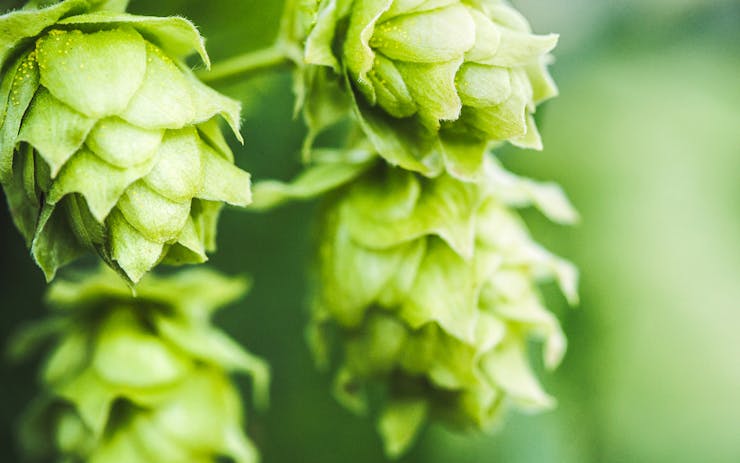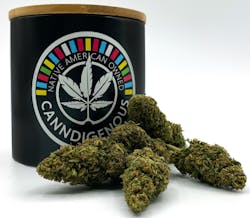Cannabidiol, or CBD, is exploding in popularity, but its uncertain legality has created barriers between consumers and providers. But what if cannabis and hemp were not the only sources of CBD?
Chemists have been able to synthesize CBD in the lab for years, but it’s wildly expensive (from one research supply source, it’s $159/10mg, and many require hundreds of milligrams to achieve therapeutic benefits) and you’re required to have a Schedule I DEA license to make the purchase. On top of that, it’s not intended for human consumption.
So instead of turning to the beaker, others are considering ways of manipulating the machinery of organisms to create CBD.Looking for CBD Near You?
CBD From Hops
One recent notable example of alternative CBD sourcing comes from the hops plant. Isodiol International Inc. claims to have created the only source of CBD from a non-cannabis plant (including hemp).
Hops are well known for their distinctive flavor they impart in the brewing of beer. But can the hops plant, Humulus lupulus, be made to produce cannabinoids like THC or CBD? Isodiol International Inc. has not shared any data supporting their ability to create CBD from hops, nor did they respond to my request for comment. So, does their hops-derived CBD product, ImmuneAG, actually contain CBD? Maybe, and in theory, it can be done. (More on that shortly.)
CBD From Yeast
Others are turning to yeast to do the hard labor of creating cannabinoids. Yeast do not naturally produce cannabinoids, but give them the right tools and it’s possible.
By manipulating their DNA, yeast can produce CBD, THC, and other cannabinoids or terpenes that would naturally be found in the cannabis plant.
Librede, a California-based company has done just that. They hold a patent and have received federal funding to mass produce cannabinoids from yeast. By manipulating their DNA, yeast can produce CBD, THC, and other cannabinoids or terpenes that would naturally be found in the cannabis plant. And they do it for far cheaper than traditional cultivation methods.
It’s a one-step process: add sugar and let the bioengineered yeast do the rest. Liberte estimates that they’ll be able to create a gram of CBD for 20 cents, far less than cultivation and extraction of CBD from cannabis or hemp plants.
Plus, there’s the added benefit of a lower environmental impact. Cannabis and hemp plants require a substantial amount of water and energy (especially for indoor grow operations). Many growers also commonly use pesticides and fertilizers that can contaminate local water supplies, which has a significant environmental impact.
The Recipe for Producing Cannabinoids
To create cannabinoids, you need two basic features: 1) the precursor molecules from which cannabinoids are made, and 2) the enzymes which convert the precursor molecules into particular cannabinoids.
In order for hops or yeast to create cannabinoids, they must first be able to produce hexanoic acid and geranyl diphosphate (GPP). Hexanoic acid is common in many plants and is eventually turned into olivetolic acid (often simply referred to as OA), where together with GPP, it is synthesized into cannabigerolic acid.
Creating cannabigerolic acid is a key milestone in the pathway to create cannabinoids. Once you’ve reached it, all you need is the right enzymes to convert it into THC, CBD, or other cannabinoids (note: technically, the enzymes convert cannabigerolic acid into the acid form of THC or CBD—heat then converts them into the familiar THC and CBD we know and love).
But this is a major holdup, as plants other than cannabis don’t possess the DNA that allows them to naturally produce these enzymes.
Adding the Ingredients
Bioengineers have developed the tools that enable yeast to produce the key ingredients in cannabinoid production. Yeast have been engineered to produce hexanoic acid (which you’ll recall is the precursor to OA) as well as the enzyme that converts cannabigerolic acid to THC acid (THCA). Librete claims that the entire process, from sugar to cannabinoid, takes less than a week. Once THCA is produced, now all you need is a flame to get high.
Is it possible to turn the hops plant into a cannabinoid producer? Yes. The new gene-manipulating technique known as CRISPR can do just that. CRISPR is a method that allows scientists to cut out a certain region of DNA and replace it with DNA of their choosing. Using CRSIPR, scientists could insert the DNA for the enzymes that convert cannabigerolic acid into THC or CBD, thus converting the hemp plant into a cannabinoid producer. Is this what Isodiol has done? They won’t say.
The issue of the medicinal effectiveness remains. For instance, whole-plant extracts of CBD-rich cannabis are known to have stronger anti-inflammatory and pain-reducing qualities than CBD on its own. Yet, by bioengineering plants or yeast to create a spectrum of cannabinoids and terpenes, with time and research, the optimal combination of “ingredients” can be created for each condition.





